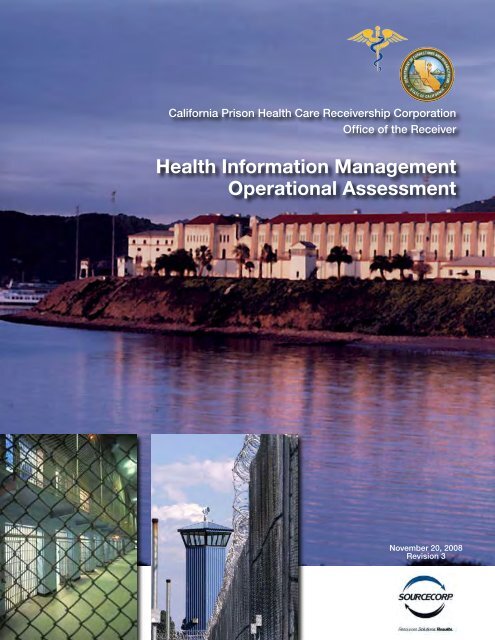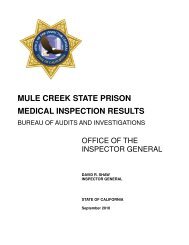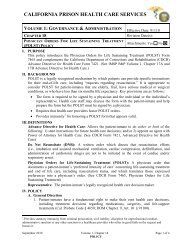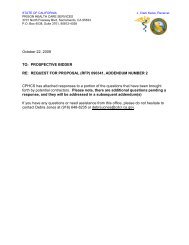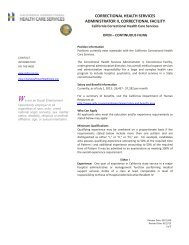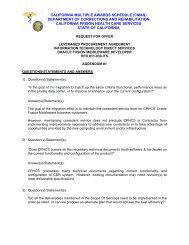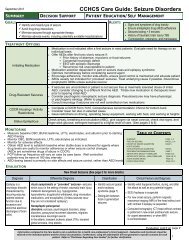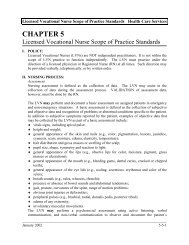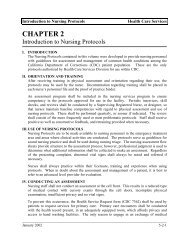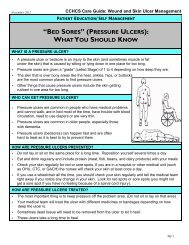Health Information Management Operational Assessment
Health Information Management Operational Assessment
Health Information Management Operational Assessment
You also want an ePaper? Increase the reach of your titles
YUMPU automatically turns print PDFs into web optimized ePapers that Google loves.
California Prison <strong>Health</strong> Care Receivership Corporation<br />
Office of the Receiver<br />
<strong>Health</strong> <strong>Information</strong> <strong>Management</strong><br />
<strong>Operational</strong> <strong>Assessment</strong><br />
November 20, 2008<br />
Revision 3
Your Partner<br />
in Quality
TABLE OF CONTENTS<br />
Executive Summary..............................................................................................1<br />
Global Summary <strong>Assessment</strong>...........................................................................11<br />
Human Resources................................................................................................12<br />
Procedural.............................................................................................................15<br />
Technology Approach...........................................................................................21<br />
Physical Infrastructure..........................................................................................26<br />
Transportation.......................................................................................................28<br />
Site Visits<br />
Full <strong>Assessment</strong>s..........................................................................................30<br />
(CIM) California Institution for Men.......................................................................31<br />
(CIW) California Institution for Women..................................................................41<br />
(CMC) California Men’s Colony.............................................................................51<br />
(CMF) California Medical Facility..........................................................................62<br />
(COR) California State Prison, Corcoran...............................................................70<br />
(DVI) Deuel Vocational Institution..........................................................................80<br />
(LAC) California State Prison, Los Angeles County..............................................88<br />
(MCSP) Mule Creek State Prison..........................................................................97<br />
(RJD) Richard J. Donovan Correctional Facility at Rock Mountain ...................105<br />
(SAC) California State Prison, Sacramento......................................................... 113<br />
One Day Visits..............................................................................................122<br />
(ASP) Avenal State Prison...................................................................................123<br />
(CRC) California Rehabilitation Center................................................................128<br />
(CTF) Correctional Training Facility.....................................................................133<br />
(FSP) Folsom State Prison..................................................................................138<br />
Other Sites...................................................................................................143<br />
<strong>Health</strong> Record Center.........................................................................................144<br />
Parole Offices......................................................................................................149<br />
Telemedicine.......................................................................................................153<br />
Documentation and Coding................................................................................157<br />
iii
Appendix 1 ........................................................................................................159<br />
Definitions<br />
Appendix 2 ........................................................................................................161<br />
Terms & Acronyms<br />
Appendix 3<br />
Equipment Analysis Spreadsheet<br />
Appendix 4<br />
<strong>Assessment</strong> Tool<br />
Appendix 5<br />
Analysis of Year 2007 Death Reviews<br />
iv
EXECUTIVE SUMMARY<br />
This report segment of the <strong>Health</strong> Records <strong>Management</strong> Services project incorporates<br />
the assessment of the <strong>Health</strong> Record Services/<strong>Health</strong> <strong>Information</strong> <strong>Management</strong> (HIM)<br />
functions taken from within a sample of institutions suggested by the HIM Steering<br />
Committee. The institutions are listed in the Table of Contents and covered in detail in<br />
their own section entitled Site Visits.<br />
Findings<br />
The picture at the right shows the conditions found throughout<br />
the institutions we assessed. Many of the problems discovered<br />
and documented, however, do not lend themselves to<br />
pictures.<br />
Rather, there are severe conditions that endanger patientinmates’<br />
health and waste resources through countless<br />
inefficient processes.<br />
The Severity Level Dashboard on the next page presents<br />
summary assessment findings that are global in nature.<br />
These abhorrent conditions are present to a greater or lesser<br />
degree in every institution we assessed. Each of the assessment<br />
findings was analyzed against three impact criteria to<br />
establish the severity level. These criteria were:<br />
1. Patient-inmate healthcare<br />
2. Compliance with internal and external policies or standards<br />
3. Efficiency in the use of resources<br />
The assessment findings were then rated by risk and priority.<br />
"While the problems identified by the<br />
courts and the Receiver reach into almost<br />
every element of the medical care system,<br />
it is without question that the health<br />
information management (HIM) system<br />
is inadequate to meet the needs of the<br />
confined adult population. The Plata Court<br />
has found that “[t]he medical records in<br />
most CDCR prisons are either in shambles<br />
or non-existent.” FFCL, at p. 20.
SEVERITY LEVEL DASHBOARD<br />
Finding<br />
Severity<br />
Level<br />
Risk Priority Areas Impacted<br />
Deficiency in<br />
•<br />
• Compliance<br />
leadership H H • Patient-inmate care<br />
• Efficiency<br />
Inadequate staffing<br />
• H H • Compliance<br />
• Patient-inmate care<br />
• Efficiency<br />
Poor record availability<br />
• H H • Compliance<br />
• Patient-inmate care<br />
• Efficiency<br />
Poor quality of health<br />
•<br />
• Compliance<br />
record content H H • Patient-inmate care<br />
• Efficiency<br />
Lack of current<br />
policies and<br />
• Patient-inmate care<br />
•<br />
• Compliance<br />
H H<br />
procedures • Efficiency<br />
Loose filing backlogs<br />
significantly exceed<br />
• Patient-inmate care<br />
•<br />
• Compliance<br />
H H<br />
standard • Efficiency<br />
Lack of chart tracking<br />
• H H • Compliance<br />
• Patient-inmate care<br />
• Efficiency<br />
Lack of release of<br />
•<br />
information (ROI)<br />
M H • Compliance<br />
• Efficiency<br />
automation<br />
Lack of encoding and<br />
•<br />
abstracting software M L • Compliance<br />
• Efficiency<br />
Suboptimal use of<br />
existing space<br />
• M M • Efficiency<br />
Inefficient and<br />
•<br />
unsecured record<br />
M M • Compliance<br />
• Efficiency<br />
transportation<br />
Major issue - immediate remediation<br />
Remediation in the near term<br />
No action required<br />
Key = Severity Level<br />
Levels<br />
H – High<br />
M – Medium<br />
L - Low
IMPACT STATEMENT<br />
The majority of the Severity Level ratings on the dash board on the previous page<br />
relate to reasons the current CPHCS patient-inmate health records are in such poor<br />
shape. The problems of the current health record, in the words of the “Analysis of Year<br />
2007 Death Reviews” by Kent Imai, MD (Appendix 5) include:<br />
1. “The typical patient health record is not easily navigated and not well<br />
organized” (page 7)<br />
2. “The health record is often incomplete, missing critical recommendations from<br />
consultants or records of off-campus procedures, emergency room visits and<br />
hospitalizations” (page 7)<br />
In the report’s analysis of patient-inmate deaths, several deaths were attributed to<br />
inadequacies of the health records, as follows:<br />
<strong>Health</strong> Record<br />
Inadequacy<br />
Non-preventable<br />
deaths (p.10)<br />
Possible preventable<br />
deaths (p.12)<br />
Preventable<br />
deaths (p.13)<br />
Unavailable record 5 2 0<br />
Failure of provider-toprovider<br />
communications<br />
in the record<br />
Failure to adequately<br />
pursue abnormal test<br />
results<br />
4 5 1<br />
13 5 1<br />
Totals 22 12 2<br />
These unnecessary deaths could have been prevented if an adequate <strong>Health</strong> <strong>Information</strong><br />
<strong>Management</strong> system existed to ensure accountability and ownership of the<br />
patient health record.<br />
Based on these findings, the <strong>Health</strong> <strong>Information</strong> <strong>Management</strong> remediation plan will<br />
eliminate preventable patient-inmate deaths related to unavailable or inaccurate health<br />
records, by:<br />
• Delivering a plan to initiate specific steps to alleviate the current issues related<br />
to the availability and quality of the health record<br />
• Facilitating effective provider-to-provider communication, by ensuring timely<br />
updates are made to the health record<br />
• Establishing best practice loose-filing standards to ensure clinical data is<br />
available in the right place at the right time<br />
• Ensuring enterprise wide health record content/quality standards are enforced<br />
• Establishing a professional <strong>Health</strong> <strong>Information</strong> <strong>Management</strong> organization<br />
whose mission will be to establish a program that will ensure timely implementation<br />
of consistent, repeatable and sustainable processes.
assessment methodology<br />
Definition<br />
<strong>Health</strong> <strong>Information</strong> <strong>Management</strong> (HIM) is an administrative service responsible<br />
for medical/health records. A medical/health record must be maintained for every<br />
individual evaluated or treated in a medical facility, as well as include every encounter<br />
for that individual. The organization of the HIM functions must be appropriate to the<br />
scope and complexity of the services provided. The enterprise must employ adequate<br />
personnel to ensure timely documentation, coding, completion,<br />
filing, and retrieval of records.<br />
HIM improves the quality of healthcare by insuring that the most<br />
accurate, timely and complete information is available to make<br />
healthcare decisions. <strong>Health</strong> information management professionals<br />
manage healthcare data and information resources.<br />
The profession encompasses services in planning, collecting,<br />
aggregating, analyzing, and disseminating individual patient<br />
and aggregate clinical data. The American <strong>Health</strong> <strong>Information</strong><br />
<strong>Management</strong> Association (AHIMA) issues two health information,<br />
three coding and privacy and security credentials.<br />
Id., at p. 21 (internal citations<br />
omitted). Simply put, “the CDCR<br />
medical records system is ‘broken’<br />
and results in dangerous mistakes,<br />
delay in patient care, and severe<br />
harm.” Id.<br />
Areas Assessed<br />
The <strong>Health</strong> <strong>Information</strong> <strong>Management</strong> (HIM) functions that were assessed at the sites<br />
include:<br />
1. <strong>Health</strong> <strong>Information</strong> <strong>Management</strong> staffing and management<br />
2. <strong>Health</strong> Record Availability<br />
3. The Unit <strong>Health</strong> Record (UHR) Workflow<br />
4. The UHR Order/Assembly<br />
5. The UHR Audit (Deficiency Analysis)<br />
6. Coding/Abstracting/Indexing/Data Collection<br />
7. <strong>Health</strong> Record Content/Documentation/Charting Guidelines<br />
8. Transfers/Discharges/Deaths<br />
9. Confidentiality/Release of <strong>Information</strong> (ROI)<br />
10. Forms Control/Loose Reports<br />
11. Plata Scheduling/Statistics<br />
12. Dictation/Transcription<br />
13. Use of Technology and Tools<br />
14. Physical Infrastructure and Layout<br />
15. Transportation of the UHR
<strong>Assessment</strong> Process<br />
The comprehensive site assessments were conducted by a team of two seasoned<br />
HIM professionals and an experienced paper record storage specialist.<br />
• The team members used a variety of methods to gather data and evaluate<br />
the <strong>Health</strong> Record functions including: interviews, observation, counting, and<br />
measurement.<br />
• A lengthy assessment survey form was the tool used to consistently and<br />
completely record the information at each site. This tool can be found in<br />
Appendix 4.<br />
• The detailed work papers with the site specific assessment documents can be<br />
accessed via the California Prison <strong>Health</strong>care System (CPHCS) Clarity project<br />
management site.<br />
Each of the three assessment team leaders reviewed the completed assessment<br />
survey forms from all sites. The resulting summaries were organized according to the<br />
five functional areas designated in the project statement of work as follows:<br />
1. Human Resources<br />
2. Procedural<br />
3. Technology Approach<br />
4. Physical Infrastructure<br />
5. Transportation<br />
The site specific findings can be found in the site visit section of this report under a<br />
heading with the name of each institution that was assessed.
CHALLENGES<br />
The need to provide the reader with a context in which our discovery process was<br />
conducted is the intent behind this section of the Executive Summary. What has<br />
become obvious to the assessors, and thus is implicitly understood, will not be obvious<br />
to the casual reader.<br />
We will strive to provide the reader with a flavor of the environment in which the <strong>Health</strong><br />
<strong>Information</strong> <strong>Management</strong> (HIM) functions are performed. HIM suffers from a secondclass<br />
citizenship mentality, in a physically-challenged work environment. They struggle<br />
to provide services without the benefit of professional supervision and training or<br />
adequate technology tools and other resources to accomplish their mission.<br />
The HIM mission is: To provide an up-to-date, accurate, and usable health record<br />
for each patient-inmate at each healthcare encounter to aid in providing quality<br />
and constitutional patient care.<br />
Background<br />
To understand the current position of <strong>Health</strong> <strong>Information</strong> <strong>Management</strong> (HIM) within<br />
the California Department of Corrections and Rehabilitation (CDCR) environment,<br />
it is instructive to reflect on the development of the role of management of health<br />
information in the correctional environment versus its role in community healthcare<br />
environments.<br />
An unbiased view of healthcare within any corrections organization would conclude<br />
that healthcare, and therefore health information management, is generally a secondary<br />
concern.<br />
1. The long legal history of healthcare within CDCR bears witness to this.<br />
2. The main focus of HIM has been custody of the health record.<br />
3. Few resources have been allocated to the HIM function.<br />
4. Little effort has been made to foster professionalism within the HIM workforce.<br />
The reader should contrast the above situation to the role of HIM in a typical community<br />
hospital.<br />
1. Custody of the health record is still a key responsibility.<br />
2. However, the evolving role of HIM in the reimbursement system since the<br />
1960s has increased the importance of HIM.<br />
3. Key performance indicators of the revenue cycle process are directly the<br />
responsibility of HIM. These have daily visibility to the CEO.<br />
4. The Joint Commission, a national accreditation body for hospitals and healthcare<br />
organizations, has established compliance criteria that are the responsibility<br />
of HIM.<br />
5. Likewise, the Center for Medicare and Medicaid (CMS) and its enforcement<br />
arm, the Department of Justice (DOJ), are authorized to examine the output of<br />
HIM, specifically the accuracy of coding.<br />
In response to these growing responsibilities, HIM has exponentially evolved in<br />
professionalism within the healthcare community. Prestigious colleges offer degrees<br />
at varying levels in HIM. There are nationally-recognized and required certification<br />
exams. In fact, California’s Title 22 requires hospitals to have a credentialed HIM<br />
professional managing health information functions.
Meanwhile, HIM has been allowed to languish as a largely clerical function in each institution.<br />
The challenges presented in this section are the direct result of this history.<br />
Difficulty of Gathering <strong>Information</strong><br />
Rare was the situation at the institutions we visited where the HIM supervisor or<br />
manager could:<br />
• Explain why many activities were being performed the way they were<br />
• Provide any reliable metrics on functional performance<br />
• Speak to the department’s authorized staffing levels or financial budget<br />
This is a very poor management foundation upon which to build a remediation<br />
program.<br />
HIM Culture<br />
We found excuses were given for most everything. The defeatism this breeds allows<br />
the following to exist:<br />
• Disregard for policies and procedures was evident.<br />
• No apparent concern for the fact health records are frequently not produced<br />
for the providers of patient care. (“We just don’t have the staff.”)<br />
• At one institution, HIM staff have ceased documenting inpatient episodes in<br />
the UHR. The result is that a provider, at a subsequent clinic appointment,<br />
would have no idea that the patient-inmate had recently been hospitalized or<br />
maybe what the medical condition was that caused the hospitalization. (“The<br />
person who used to do this retired and has not been replaced.”)<br />
• A small storage room, lit by a single light bulb which burned out, has been<br />
dark for two months. (“It takes forever to order things around here.”)<br />
A culture like this is very negative and the hopelessness it breeds will need to be<br />
addressed during remediation.<br />
Technology Infrastructure<br />
HIM functions are performed in an environment where almost all computers are stand<br />
alone computers without networking capability. This means:<br />
1. Few HIM staff have e-mail to communicate<br />
2. Few HIM staff have Internet connectivity to access training or other knowledge<br />
resources<br />
3. There is limited access to applications to use in processing transactions<br />
4. There is heavy reliance on Access databases and intra-facility trading of<br />
information with flash drives<br />
5. There is no mechanism to communicate throughout the Corrections environment,<br />
even the telephone systems are primitive<br />
The good news is that this technology shortfall is being addressed by an enterprise<br />
wide technology rollout that will provide local area network (LAN), wide area network<br />
(WAN), connectivity, and enhanced telecommunications capability.
This environment is not conducive to standardization or collaboration to foster<br />
effective work and is a major reason for low productivity and lack of initiative.<br />
Physical Facilities<br />
HIM suffers the same handicap as other functions in most of the institutions; namely<br />
that overcrowding, in often aging facilities, has put a huge premium on both the amount<br />
and location of space for allocation to HIM. Add to this factor the move toward spread<br />
out campus designs stretch the capability of resources for the paper record intensive<br />
processes currently used to bring patient-inmate health records to treatment areas.<br />
In the short run this is a fact of life. There are initiatives in place for retrofit<br />
construction to relieve the worst space problems. In addition, imaging technology<br />
is planned to help bridge the issue of distance and dispersion within two<br />
years.<br />
Institutional Independence<br />
Notwithstanding representations to the contrary, it is clear that the HIM functions<br />
within institutions have been allowed to evolve in their own directions. This is exemplified<br />
by:<br />
1. There is little consistency in the HIM procedures between institutions<br />
2. There is no culture of sharing and inter-institution meetings are extremely rare<br />
3. The regional HIM structure was rarely mentioned by sites and seems invisible<br />
4. Institution-specific health record forms continue to spring up everywhere<br />
5. The CDCR Policy and Procedure Manual, Department Operations Manual<br />
(DOM), is out-of-date and is frequently ignored as being a valid resource<br />
authority by HIM staff in the field<br />
This chaotic situation does not allow for implementation of standards or accountability<br />
and needs to be reversed during remediation.<br />
Are there any bright spots<br />
In spite of the handicaps placed on the HIM function within CDCR, there are rays of<br />
hope, namely:<br />
• There are HIM individuals at institutions within CDCR for whom all is not<br />
hopeless. They exhibit a “can do” attitude and high spirits<br />
• Without exception the institution-level healthcare providers are very supportive<br />
of the need for a properly functioning HIM area<br />
• The many healthcare related projects initiated by CPHCS are beginning to<br />
have a positive impact at the institution level, which gives all staff more confidence<br />
that major positive change will occur<br />
Leveraging the positive will be important in managing change.
assessment Findings<br />
Use of Global <strong>Assessment</strong> Findings<br />
The global findings documented in this report define the current status of <strong>Health</strong><br />
Records in the California Department of Corrections and Rehabilitation (CDCR).<br />
The gap between these global findings and the desired state for <strong>Health</strong> <strong>Information</strong><br />
<strong>Management</strong>, described in the previous Compliance, Regulatory and Best Practices<br />
report, will form the basis of the remediation plan.<br />
Site Specific <strong>Assessment</strong> versus Global <strong>Assessment</strong><br />
Each assessment team documented the comprehensive findings for each site visited.<br />
The synthesis of commonality of findings across the sites visited and assessed<br />
resulted in the global summary assessment findings documented in this report. Site<br />
specific remediation areas at the end of each assessment are considered unique to<br />
that institution.
Receivership’s Mission<br />
Reduce unnecessary morbidity<br />
and mortality and protect<br />
public health by providing<br />
patient-inmates timely access<br />
to safe, effective and efficient<br />
medical care, and coordinate<br />
the delivery of medical care<br />
with mental health, dental and<br />
disability programs.<br />
10
GLOBAL SUMMARY ASSESSMENT<br />
This portion of our report focuses on each of the functional elements of <strong>Health</strong> Records<br />
that, if consistently standardized, would promote more effective and efficient health<br />
information management thereby promoting a constitutional level of care. The following<br />
findings have universal applicability across the California Department of Corrections<br />
and Rehabilitation (CDCR) institutions. As such, they represent the current<br />
environment of <strong>Health</strong> <strong>Information</strong> <strong>Management</strong> (HIM) upon which remediation will<br />
be based. While we acknowledge there may be institution-specific variations to our<br />
global assessment findings, we are confident these global findings will form a basis<br />
for remediation planning. The detailed remediation plan will adjust for site specific<br />
differences.<br />
Global<br />
Summary<br />
<strong>Assessment</strong><br />
Summary of <strong>Assessment</strong> Findings<br />
AREA<br />
Human Resources<br />
Deficiency in leadership<br />
FINDING<br />
Inadequate staffing<br />
Procedural<br />
Poor health record availability<br />
Poor quality of health record content<br />
Lack of current policies and procedures<br />
Loose filing significantly exceeds goal<br />
Technology Approach<br />
Lack of chart tracking<br />
Lack of release of information automation (ROI)<br />
Lack of encoding and abstracting software<br />
Physical Infrastructure<br />
Transportation<br />
Suboptimal use of existing space<br />
Inefficient and unsecured record transportation<br />
11
HUMAN RESOURCES<br />
Deficiency in Leadership–––––––––––––––––––––––––––––––––––––––––––<br />
Background<br />
Prior to becoming familiar with California Department of Corrections and Rehabilitation<br />
(CDCR), we would have anticipated there to be sufficient professional subject<br />
matter expertise and leadership in a headquarters/regional organization related to a<br />
function as important as <strong>Health</strong> <strong>Information</strong> <strong>Management</strong> (HIM). This is the model<br />
found in private sector healthcare organizations that are as massive and geographically<br />
dispersed as the CDCR institutions.<br />
Approach<br />
Identifying the lack of a <strong>Health</strong> <strong>Information</strong> <strong>Management</strong><br />
(HIM) leadership structure was obvious during site visits.<br />
Spending time to understand the evolution and current<br />
culture of healthcare and health records within CDCR was<br />
important to appreciate why the current state exists.<br />
Findings<br />
There is an absence of an adequate central management<br />
structure (headquarters and regions) composed<br />
of HIM professionals focused on the typical “corporate”<br />
objectives:<br />
1. Uniformity of practice<br />
2. Inter-facility staffing augmentation<br />
3. Quality improvement and assurance<br />
4. Development and participation in strategic initiatives<br />
The HIM units were often seen to be drifting along without direction. The staff appeared<br />
to be working hard, but with a limited long-term view.<br />
During interviews, there was frustration expressed about the Human Resource process<br />
being an obstacle to defining adequate management positions for HIM within CDCR.<br />
We would expect that could be addressed during remediation.<br />
Implication<br />
<strong>Health</strong> record processing has no corporate voice equivalent to the importance of the<br />
health record in the broader function of providing constitutionally adequate healthcare<br />
to patient-inmates within CDCR. The science of health records is far more than a<br />
glorified clerical function … a status to which it seems to have been relegated. Having<br />
an adequate HIM management structure in both headquarters and in a regional structure<br />
would increase the likelihood that:<br />
1. The HIM functions in each institution would be supported<br />
2. Quality assurance of existing functions would be performed and corrective<br />
action taken<br />
3. System wide improvements would be initiated and maintained<br />
4. HIM would be represented in other Enterprise initiatives<br />
You have to ask<br />
yourself what kind<br />
of HIM leadership<br />
would allow<br />
these conditions<br />
to occur, let alone<br />
persist.<br />
12
Inadequate Staffing–––––––––––––––––––––––––––––––––––––––––––––––<br />
Background<br />
An important aspect of assessing similar functions across many institutions is to utilize<br />
a staffing model to determine if the workforce is adequate to accomplish the assigned<br />
responsibilities. Staffing adequacy has three dimensions:<br />
Approach<br />
1. Adequacy of skill levels (documented competencies)<br />
2. Availability of staff coverage (in relationship to facility needs)<br />
3. Sufficiency of staff head count<br />
• Effectiveness of staff (productivity)<br />
• Validated volumes for each functional task<br />
Staffing adequacy was assessed at each site by:<br />
Findings<br />
We found:<br />
1. Determining head count and position levels from department sources<br />
2. Interviewing staff<br />
3. Observing staff at work<br />
4. Evaluating unique duties (if any) within the HIM departments as well as needs<br />
of the institution<br />
1. Lack of qualified management and supervision<br />
2. Insufficient numbers of staff for the work<br />
3. Insufficient skill mix of staff<br />
4. Coverage not conducive to supporting the healthcare function. (There was no<br />
maximization of staff through use of evening and weekend hours to perform<br />
non-time sensitive activities.)<br />
5. Volume measurements for workload factors is not captured or could not be<br />
validated<br />
In addition, there is a major missing factor that makes it difficult to both manage<br />
and staff <strong>Health</strong> <strong>Information</strong> <strong>Management</strong> (HIM) units. Specifically, there is a lack<br />
of productivity standards to use a goal and to monitor. Universally accepted and<br />
adopted standards are available throughout the healthcare industry.<br />
Additional findings that relate to staffing and thereby affect the effective and efficient<br />
management of health information include:<br />
1. Job descriptions which do not specifically call out the unique skill set related<br />
to HR functions and responsibilities<br />
2. Significant turn-over with staff due to absence of career ladders within the<br />
<strong>Health</strong> <strong>Information</strong> <strong>Management</strong> area. (Time and money is invested to train<br />
newly hired staff who subsequently transfer out of HIM to obtain more senior<br />
positions within CDCR.)<br />
13
3. No evidence of continuing education to develop the skills of current staff and<br />
to stay current with trends and best practices within the industry<br />
4. Lack of tools and resources that would help staff be more productive<br />
Implication<br />
Having at least one credentialed HIM professional in each HIM<br />
unit would raise the professionalism within the department and<br />
institution, as well as increase the likelihood that decisions rooted<br />
in HIM’s body of knowledge and best practices would be appropriately<br />
made and priorities set and achieved.<br />
There will be continuing backlogs and substandard performance<br />
in important HIM functions until staffing is improved. Proper levels<br />
of staffing are key to improving HIM performance. This includes:<br />
• Increased staffing with personnel possessing the applicable<br />
competencies will help assure the required work is<br />
performed at the necessary level of proficiency<br />
• Expansion of days and hours of coverage (with appropriate<br />
supervision) would enable a more orderly approach<br />
to accomplishing the work, access to equipment, and<br />
process improvements.<br />
There were issues identified with Plata schedulers - some<br />
departments with all schedulers reporting to them, others with<br />
no schedulers reporting to HIM and some with a split of schedulers<br />
between HIM and another department. Remediation staffing<br />
models will require clear delineation of where this process should<br />
be managed.<br />
Lack of formal training and HIM<br />
knowledge in the institutions leads<br />
to poor decisions. In one institution<br />
turnover in one position lead to<br />
the decision to stop summarizing<br />
inpatient visits into the Uniform<br />
<strong>Health</strong> Record (UHR).<br />
The result:<br />
• No record of inpatient treatment<br />
recorded in the UHR<br />
• Providers will have no way of<br />
knowing that the patient-inmate<br />
was treated as an inpatient, for<br />
what condition and on what<br />
meds<br />
• One provider found out about<br />
a patient-inmate having a heart<br />
transplant only by observing the<br />
huge, fresh chest scar<br />
14
Procedural<br />
Poor <strong>Health</strong> Record Availability–––––––––––––––––––––––––––––––––––––<br />
Background<br />
We were guided in our targeting of health record availability by wording present<br />
in the original legal cases that eventually led to the establishment of the Receivership.<br />
The importance of having health records present when treatment is<br />
provided cannot be emphasized too heavily. While there have been attempts<br />
at improving health record availability within the current system, these attempts<br />
come up short.<br />
Approach<br />
Our assessment of record availability was accomplished in several ways:<br />
Findings<br />
• The measurements provided in monthly Plata reporting (when available)<br />
• The input of various clinical providers<br />
• Counting or accepting findings from various listings when available<br />
We found that health record availability was significantly below Best Practice<br />
standards. Actual measurement ranged from 50% to 93%. Adhering to the old<br />
adage “that perception is reality”, providers universally listed health record availability<br />
as a key obstacle to providing adequate healthcare.<br />
This finding is not surprising given the heavy reliance on manual tracking and<br />
limited intra-institution bar coding tracking. Availability failures occur for the<br />
following reasons:<br />
1. Lack of health record tracking discipline and tools within most institutions<br />
2. Lack of tracking capability involving intake and outtake<br />
3. Inability to track and resolve non-compliance<br />
4. Existing chart tracking systems (3 different products) are not integrated or<br />
networked<br />
5. Providers will retain records with the knowledge that HIM is unaware of<br />
records kept out of file overnight<br />
6 Patient-inmates with multiple appointments within the same day greatly<br />
decreased the percentage of chart availability<br />
Using the definition of an<br />
“available record” to be<br />
a complete record with<br />
the latest results located<br />
in the correct order in the<br />
record and at the place<br />
of treatment of a patientinmate<br />
… providers<br />
routinely cited 50-60%<br />
record availability for<br />
their clinic appointments<br />
during our interviews.<br />
The implications:<br />
• Providers struggling<br />
or unable to determine<br />
health status<br />
• An epidemic of<br />
appointments<br />
rescheduled due to<br />
lack of test result<br />
availability<br />
Implication<br />
Poor health record availability is the single most important finding in our assessment.<br />
Remediation is key to improving patient-inmate healthcare. The ability to<br />
implement chart tracking systems will depend on the availability of other technology<br />
improvements.<br />
Even when records are available, misfiling and loose materials in the the charts make it<br />
difficult for clinicians to find information needed for medical treatment. Duplicate copies<br />
of documentation, preliminary results and inconsistent placement of documents adds<br />
to the unwieldy nature of the UHR.<br />
15
Poor Quality of <strong>Health</strong> Record Content––––––––––––––––––––––––––––––<br />
Background<br />
The primary health record in CDCR institutions is the Unit <strong>Health</strong> Record (UHR) which<br />
is contained in one or more multi-sectioned green file folders (see picture). The UHR<br />
should contain documentation from medical, dental, and mental health outpatient<br />
visits and a summary of inpatient visits.<br />
Approach<br />
Our assessment of record content was accomplished in several ways:<br />
Findings<br />
• At each institution the assessment team analyzed 10<br />
UHRs<br />
• A medical documentation specialist reviewed 40 total<br />
records at CMF and CMC<br />
• The assessment teams interviewed providers at each<br />
institution<br />
Physicians universally complained about the following aspects<br />
of record content:<br />
1. Order of the UHR … as it varies both within and between<br />
institutions<br />
2. Actual documentation in the charts … uniformity of<br />
forms has become a casualty as institution-designed<br />
forms proliferate<br />
3. Lack of current clinical information … caused by loose<br />
sheet backlogs<br />
4. Unruly UHRs which are overstuffed and falling apart<br />
5. Poor forms design with redundancy and questionable<br />
clinical relevance<br />
Our detailed analysis found: unsigned physician orders, unprocessed requests for<br />
services, incomplete problem lists, forms with copies still attached (such as orders<br />
and preliminary and final results) as well as outdated forms. Departmental policies<br />
and procedures intended to prevent many of these issues are not being followed.<br />
Finally, there are no quality control procedures in place to ensure completeness and<br />
integrity of the UHR.<br />
Implication<br />
The UHR is difficult to use at best, and frequently so incomplete as to necessitate<br />
cancellation or rescheduling of clinic appointments. Thus, patient-inmate treatment is<br />
not supported and inefficiencies abound. This situation seriously compromises care<br />
and frustrates providers.<br />
16
Lack of Current Policies and Procedures––––––––––––––––––––––––––––<br />
Background<br />
The more geographically disperse the enterprise, the more important standard policies<br />
and procedures are to establish, encourage, and enforce uniformity of process, and<br />
therefore outcome. Credibility of such standard policies and procedures erodes when<br />
they are not updated for years at a time.<br />
The Department Operations Manual (DOM) was referenced minimally<br />
by <strong>Health</strong> Record Supervisors/Directors – seemingly not utilized to<br />
guide practice.<br />
Approach<br />
We sought to review policies and procedures everywhere we assessed.<br />
When we interviewed supervisors and staff, we sought to understand<br />
how the policies and procedures were used and followed in the field.<br />
“We made up our own policies<br />
and procedures to cover those<br />
situations.”<br />
Anonymous HIM staff<br />
Findings<br />
The existing policies and procedures are not current. The field has different versions,<br />
indicating the policies and procedures don’t apply to their institution or have modified<br />
the policies/procedures to match their own practice.<br />
The above finding sounds rather benign. However, enforcing current, comprehensive<br />
policies and procedures is the foundation to eliminate the following serious problems<br />
that are endemic throughout HIM.<br />
If we just focus on issues with the Unit <strong>Health</strong> Record (UHR), enforcement of proper<br />
policies and procedures would address the following problems<br />
1. Many UHR s are so stuffed with historical documentation, much of which is<br />
duplicative, that:<br />
• Bindings burst and volumes become so heavy that they are cumbersome for<br />
providers to use while providing healthcare<br />
• Filing more documentation for current encounters is difficult<br />
• Lifting and filing UHR volumes is actually dangerous<br />
Enforcement of proper policy would call for routinely thinning duplicate reports out<br />
of each record and volumizing more frequently to hold the size to a much thinner<br />
standard.<br />
2. The organization of the UHR is supposed to be uniform across the enterprise,<br />
but it is not:<br />
• There were differences in the sequence of documents across a sample of<br />
UHRs<br />
• There are non-standard forms included at many institutions<br />
Enforcement of proper policy would result in standard UHR content and sequence<br />
which would facilitate patient-inmate care by making the record much more userfriendly<br />
to the providers.<br />
17
3. The filing sequence and purging practices vary from institution to institution:<br />
• Some institutions have inefficient, non-standard ways of filing UHRs that<br />
cause departmental inefficiencies<br />
• Purging rules vary<br />
Enforcement of proper policy would result in standard UHR filing and purging<br />
processes.<br />
Once there are effective policies and procedures, then:<br />
• <strong>Management</strong> becomes easier<br />
• Compliance auditing becomes feasible<br />
• Enforcement of error correction becomes practical<br />
Implication<br />
Without current policies and procedures, it is difficult to:<br />
1. Manage the HIM function<br />
2. Train staff<br />
3. Define and maintain a useable health record<br />
4. Obtain uniform results across the enterprise, particularly in the UHR<br />
5. Leverage experience to improve process<br />
6. Ensure facilities are compliant with regulatory practices<br />
7 Implement continuous process improvement<br />
18
Loose Filing Backlogs Significantly Exceed Standard––––––––––––––––<br />
Background<br />
In paper-based health records loose reports are<br />
inescapable. Getting them filed in the respective<br />
UHR is always a challenge. Loose filing must be<br />
current because:<br />
Approach<br />
1. Unfiled loose reports are often lab and other<br />
diagnostic results, reports from external<br />
providers and progress notes from visits in<br />
which the UHR was not available<br />
2. A health record with missing, unfiled loose<br />
reports may be dangerously incomplete<br />
3. Unfortunately, loose reports tend to be the<br />
most current information and therefore most<br />
relevant to patient care<br />
4. This incompleteness exposes the provider to<br />
making medical decisions without the latest<br />
results or not making decisions due to lack<br />
of information<br />
The amount of unfiled loose reports at each site was<br />
determined by requesting status from the supervisor<br />
in charge and directly observing/measuring piles of<br />
filing waiting to be inserted.<br />
Findings<br />
There are unfiled loose reports at all institutions. Best<br />
Practice dictates that unfiled loose reports should<br />
be limited to one day after receipt. We found loose<br />
reports from as far back as 60-90 days.<br />
The establishment of the <strong>Health</strong> Record Center (HRC)<br />
at Depot Park (aka Army Depot) in 2007 gave rise to<br />
a massive relocation of health records from institutions<br />
and regional record storage areas throughout<br />
the state to the HRC.<br />
• Included in the health records shipped to<br />
the HRC were over 3,500 boxes of partial<br />
records and loose reports<br />
• There are varying opinions as to the<br />
usefulness and criticality of this material to<br />
completing the health records to which they<br />
belong*<br />
The amount of unfiled, disorganized and literally<br />
unusable medical records paperwork at some<br />
prisons is staggering. At California Institution for<br />
Men (CIM), the records were kept in a 30 foot long<br />
trailer with no light except for a small hole cut into<br />
the roof and were arranged into piles without any<br />
apparent order. Conditions are similar at other<br />
prisons as well. At some prisons, medical records<br />
are completely lost or are unavailable in emergency<br />
situations.<br />
Clerical discipline is the key to minimizing the amount<br />
of unfiled loose reports. Backlogs of unfiled loose<br />
reports occur for the following reasons:<br />
19
1. Misunderstanding how important loose reports may be to the provision of<br />
adequate healthcare<br />
2. Lack of management focus on this issue<br />
3. Inadequate identification of patient-inmate information on loose reports<br />
4. Care areas do not take the time to incorporate a report when they have the<br />
UHR present – seeing it as “not their job” to file<br />
5. The UHR is continually moving making it difficult for timely incorporation of<br />
material<br />
Implication<br />
Not filing loose reports in the correct UHR is dangerous to patient care.<br />
• Correcting it in the institutions is a matter of setting priorities as the worst<br />
offender was no more than a month’s worth of work behind<br />
• Correcting the situation at the HRC, on the other hand, is a massive undertaking<br />
which will be fully explored during remediation planning<br />
Note: A sample analysis is being conducted of the 3,500 + boxes to determine the<br />
exact nature of the health record material in them. Final results are not yet available,<br />
but preliminary results indicate that there is a considerable amount of current, original<br />
health record documentation contained in the boxes.<br />
Additional challenges:<br />
• Loose documents are often received weeks or months after creation<br />
• Records are decentralized at many of the facilities however location information<br />
is not recorded on the loose documents<br />
• Printed forms are not hole-punched which discourages filing of the document<br />
at the time of creation<br />
• The number of pages in a Medication Administration Record (MAR) has<br />
multiplied (approximately times ten) since implementation of computerized<br />
pharmacy systems<br />
• Filing backlogs at institutions with reception centers significantly impacts care<br />
throughout all of the institutions<br />
20
Technology Approach<br />
Lack of Chart Tracking–––––––––––––––––––––––––––––––––––––––––––––<br />
Background<br />
Large, complex paper-based health records are usually managed with an automated<br />
chart tracking system. The more dispersed the health records are and the more intersite<br />
transfers that occur, the more important the system is.<br />
Approach<br />
We reviewed how records are tracked at every site we assessed.<br />
Findings<br />
There are a variety of chart tracking solutions used throughout the organization.<br />
None have capability beyond the boundaries of an individual institution. The existing<br />
systems have some merit, but even within the institution the value is minimal.<br />
At the <strong>Health</strong> Record Center (HRC), which has the most extensive amount of records,<br />
record inventory and control is established through a combination of Access data<br />
bases and periodic manual audits.<br />
Implication<br />
Accurate, timely chart tracking is the key to improving record availability. CDCR will<br />
have a need to manage paper records for the foreseeable future. Applying the lessons<br />
of other conversions to the CDCR environment suggests:<br />
• Transitions to electronic records are lengthy, during which paper records exist<br />
• The history that exists will be maintained for at least 10 years following implementation<br />
of electronic health records<br />
• The UHR for inmates remaining in the system will likely exist in paper form for<br />
some lengthy time period unless destruction policies change<br />
Computerized chart tracking systems (such as CRIS, MedCats, and MJTS) are in<br />
use at some institutions however each system is stand-alone and does not provide<br />
required access. At least one of the computerized chart tracking systems in use is<br />
not networkable.<br />
Many of the institutions rely on manual chart tracking systems and chart locations<br />
are usually not updated as changes occur. The end result is that charts cannot be<br />
retrieved in a timely fashion and sometimes can’t be found at all.<br />
The various current paper and/or electronic chart tracking systems are antiquated,<br />
inadequate, and broken.<br />
An enterprise-wide system is needed to facilitate tracking of medical charts within<br />
each institution as well as between the various institutions including HRC. Various<br />
industry standard chart tracking systems are available and should be considered<br />
for implementation. These systems include SoftMed, and Quadramed as well as<br />
other applications incorporated into health information management software suites.<br />
21
Remediation planning will include evaluation of various software solutions to address<br />
all HIM applications: Chart Tracking, Release of <strong>Information</strong>, Encoding and Abstracting,<br />
and Chart Deficiency.<br />
There is recognition of the need to interface these technology solutions with other<br />
projects such as Enterprise Master Index, Dictation and Transcription, Scheduling and<br />
Electronic Document <strong>Management</strong>. A single system for scheduling will be required<br />
to improve chart availability. SOURCECORP is and will participate in these other<br />
projects as required.<br />
22
Lack of Release of <strong>Information</strong> (ROI) Automation– –––––––––––––––––––<br />
Background<br />
There is a large volume of requests from both outside entities and from inmates for<br />
copies of health record information contained within the UHRs and the inpatient<br />
records. Olson reviews have had a major impact on the workload of HIM departments.<br />
Due to inmates requesting multiple copies on a daily basis, inefficiencies are<br />
created for both custody and healthcare. HIM clerical staff have some concerns about<br />
security while meeting with inmates, often unaccompanied by custody.<br />
Approach<br />
How requests for information are tracked and fulfilled at each institution was assessed<br />
through observation and interview.<br />
Findings<br />
All work is performed on a manual basis. Tracking, utilizing manual<br />
logs, is confined to requests that have been processed. Pending<br />
requests are not tracked, therefore backlogs are not recognized and<br />
not managed. Hundreds of requests at the <strong>Health</strong> Record Center<br />
is particularly remarkable. Many of these requests are the result of<br />
inaccurate or missing patient-inmate moves.<br />
Implication<br />
Measuring request volume and turnaround time is difficult at best.<br />
This equates to an inability to apply a staffing model to effectively<br />
manage this function.<br />
Ensuring legally mandated, timely responses to requestors is<br />
dependent on each staff person performing ROI functions being<br />
accountable. There is no efficient automated look-up available when<br />
following up on or tracking requests.<br />
Requests for release of patient<br />
information are only logged in when<br />
the clerk picks up the request or<br />
subpoena and goes to pull the file,<br />
make the copies, and mail it out.<br />
• This means there is no way to<br />
know the true backlog<br />
• Assessors reported seeing<br />
requests over 3 months old<br />
remaining unfilled<br />
In summary, we cannot detect how far out of compliance CPHCS is with the requirements<br />
to provide patient-inmate health information to valid requesters.<br />
23
Lack of Encoding and Abstracting Software–––––––––––––––––––––––––<br />
Background<br />
Large healthcare organizations generally utilize standard software to guide the coding<br />
and abstracting of clinical information. Coded clinical data is used for a variety of<br />
internal and external activites – credentialing, budgeting, quality care review, risk<br />
management and performance improvement. Coding activities within CDCR have<br />
no automated support. Minimal abstracting is performed and entered into CADDIS;<br />
however, there are no quality measures that ensure the integrity of this data.<br />
Approach<br />
Presence and use of encoding and abstracting software was assessed at each institution<br />
visited through observation and interviewing key staff. When staff members were<br />
interviewed, we sought to understand what technology was utilized, as well as what<br />
the data source was for the information being submitted.<br />
Findings<br />
1. No coding and abstracting automation was observed, and there was no<br />
knowledge of its existence anywhere in the enterprise.<br />
2. The Census and Discharge Data <strong>Information</strong> System (CADDIS), into which<br />
codes are entered, has not been updated to accept entry of the currently<br />
utilized ICD-9-CM diagnosis codes<br />
3. Some facilities only enter admitting diagnosis while others code all procedures<br />
and diagnoses available at discharge<br />
4. Some facilities enter all UB04 data from external provider billing and some only<br />
enter the prinicipal diagnosis and procedure (as provided by the HCCUP)<br />
5. Coding was performed by staff with no professional training and corresponding<br />
credentials. When asked, staff expressed little to no understanding of<br />
anatomy and physiology, medical terminology, or pharmacology; all of which<br />
are necessary for accurate classification of diseases and procedures.<br />
6. Additionally, tools such as coding books and current national coding<br />
guidelines were either outdated or completely absent. Unfortunately, due to<br />
no formal training, staff and leadership were not even aware that this was<br />
problematic.<br />
7. Many staff with coding responsibility utilize “cheat sheets” which do not have<br />
updated codes available<br />
8. Coding is performed only for inpatients<br />
24
Implication<br />
Without coding and abstracting software, it is difficult to:<br />
1. Abstract and capture the range or specialization and acuity of care being<br />
rendered<br />
2. Aggregate data to evaluate the need for patient-inmate programs<br />
3. Evaluate provider performance and track provider volume<br />
4. Perform Quality Assurance or Risk <strong>Management</strong> related to care provided<br />
5. Develop tools, such as Clinical Pathways that standardize care provided<br />
6. Obtain uniform results across the healthcare continuum<br />
In summary, the initial gap between data and useful information appears to be quite<br />
large.<br />
25
Physical Infrastructure<br />
Suboptimal Use of Existing Space– –––––––––––––––––––––––––––––––––<br />
Background<br />
There is almost universally a shortage of space for HIM operations and health record<br />
storage. This has three causes:<br />
Approach<br />
• Aging buildings built without much thought of health record processing<br />
• Prison overcrowding<br />
• The expansion of healthcare services in recent years<br />
We observed HIM office space on each assessment.<br />
Measurements, layout CAD drawings, and pictures document<br />
the record storage space and need to plan for growth, as well<br />
as optimizing existing space.<br />
Findings<br />
Many sites have limited office space and filing capacity. The<br />
files for storage of the UHRs and inpatient records do not<br />
always make optimal use of space:<br />
1. Fixed shelving is often used, rather than more spacesaving<br />
designs<br />
2. Frequently the shelving is not designed specifically<br />
for medical records<br />
3. Files are sometimes arrayed throughout the entire<br />
horizontal sections of shelving versus vertically within<br />
sections making access by more than one person<br />
difficult and making work much more inefficient<br />
4. Desks are generally large, non-ergonomic wooden<br />
Prison Industry Authority (PIA) products placed without consideration of work<br />
flow<br />
5. There are almost no spaces for storing records that have been pulled, as well<br />
as area for sorting of records and loose material<br />
6. Connex trailers generally do not have shelving for storage and are not climate<br />
controlled<br />
7. Storage spaces are frequently shared space where sometimes other departments<br />
deposit unwanted equipment<br />
8. Many of the sites have multiple locations for <strong>Health</strong> <strong>Information</strong> <strong>Management</strong><br />
without the tools to support decentralized services<br />
9. Some of the departments have little security for the entrance to the department<br />
and sometimes no designated space for physicians to complete their<br />
records<br />
10 SOURCECORP is engaged to provide consulting services to the retrofitting<br />
team for several of the facilities. Recommendations can be found in the<br />
section for One Day Visits<br />
26
Implication<br />
The inadequate HIM space layout has several consequences:<br />
1. The overcrowding of areas causes staff to be<br />
inefficient<br />
2. File layout impacts access and ability of staff to be<br />
in the files at the same time<br />
3. Decentralized HIM space generally makes staff<br />
less efficient moving records, loose reports, etc<br />
between locations<br />
4. Difficult to be organized without the space and<br />
tools<br />
5. Providers and other reviewers are reluctant to come<br />
to the department<br />
6. Layouts of some departments encourage traffic<br />
throughout the work areas<br />
7. Transcriptionists and others whose work demands<br />
quiet are not able to concentrate<br />
27
Transportation<br />
Inefficient and Unsecured Record Transportation–––––––––––––––––––<br />
Background<br />
There is intra-institution transportation generally provided by HIM staff. Depending<br />
on the physical design of the institutions, physical transport of health records varies<br />
considerably. The general issue is to move records from the HIM work areas to the<br />
appropriate clinical settings to support appointments (scheduled or non-scheduled).<br />
• Transportation may be inside a single building<br />
• It also may involve transporting outdoors to another building<br />
• Distances range from a hundred yards to a mile or more<br />
Inter-institutional transport occurs as the record accompanies the<br />
transfer of inmates.<br />
Approach<br />
Transportation was observed on each assessment. Generally consultants<br />
accompanied staff on delivery or pick-ups. HIM staff members<br />
were interviewed about issues regarding transporting of records.<br />
Findings<br />
Inadequate vehicles, sometimes commandeered by others, require<br />
manual loading and are not always weather protected. Some transport<br />
methods do not protect the confidentiality of the records and<br />
abuse the physical nature of the folders. All processes require lifting<br />
of boxes or crates or records by staff that may not see this as part of<br />
office routine. Carts and other transportation tools are not sized to<br />
support the UHRs and cannot be pushed across some of the terrain.<br />
Carts to support refiling of records in the aisles and loose filing have<br />
not been purchased for most sites.<br />
Boxes of health records transported<br />
around the institutions routinely<br />
weigh 30-40 lbs.<br />
• No uniform containers<br />
• Boxes have to be hoisted around<br />
by a largely female work force<br />
leading to unsafe working conditions<br />
and high turnover<br />
• Depending on the physical<br />
layout of the institution, inclement<br />
weather is a ongoing threat<br />
to record integrity<br />
Implication<br />
1. There is a universal issue of too much heavy lifting which can lead to workers’<br />
compensation claims. It also may lead to staff turnover<br />
2. Records are not sufficiently secure from a privacy perspective; not all vehicles<br />
are covered for protection from the elements<br />
3. There are productivity issues, as frequently several staff members are delivering<br />
or picking-up multiple times during the day<br />
4. Lack of tools will impact efficiency and effectiveness of processes<br />
This type of environment does not enhance respect for the health record<br />
28


